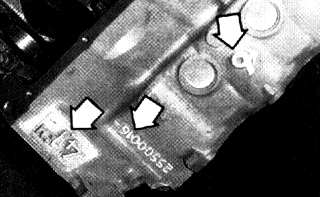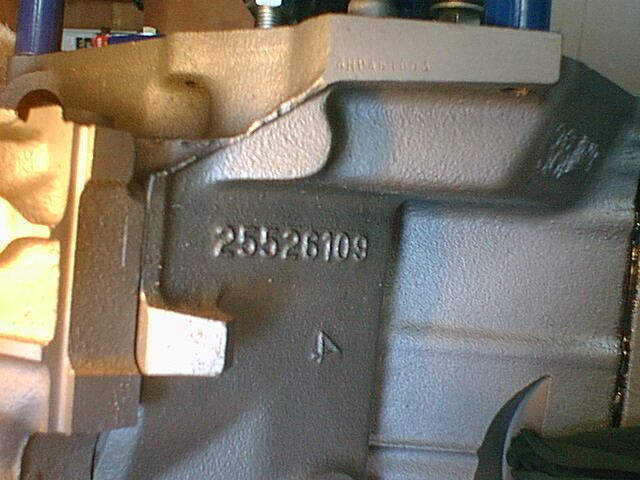 The Buick V6 is an amazing motor, by all standards. Throughout the years, several improvements have been made to strengthen the block structure, improve oiling and to increase strength. The addition of turbocharging has resulted in stronger and stronger blocks through out the years. Click here for more of a run down of the evolution of the V6.
The Buick V6 is an amazing motor, by all standards. Throughout the years, several improvements have been made to strengthen the block structure, improve oiling and to increase strength. The addition of turbocharging has resulted in stronger and stronger blocks through out the years. Click here for more of a run down of the evolution of the V6.As far as production blocks go, the 1986/87 castings are the culimination of this development. The Turbo and Normally Aspirated blocks (Casting number 25526109) appear to be identical except for the addition of the turbo oil drain back hole on the turbo version. They feature a solid cast intake area around the lifter bores, improved oiling passages (bigger to the mains), and cast "ribs" in some areas to increase rigidity as compared to the earlier blocks. Despite years of rumors that the turbo blocks had some sort of difference in metallic composition, it appears (see the section below) that this was not the case.
The Stage family of Buick Motorsports blocks are definitely a different breed. They provide incredible strength and several unique features as noted in the sections below.
 |
 |
|
|
|
Metallurgic Notes
Casting 25526109 Turbo Block
EDX analysis showed a large peak at ~6.4 KeV which is Iron (Fe). A secondary peak occurred at ~7.0 KeV which is also Iron (Fe). No other emission lines that correspond to Iron (Fe). A small peak was present at ~1.7 KeV which is Silicon (Si). There were no emissions in the range of Nickel (Ni) ~7.5 KeV and ~0.8 KeV. No emissions in the range of Manganese (Mn) ~5.9 KeV and ~0.6 KeV.
Composition: Iron and some Silicon
Casting 25526109 NA Block
EDX analysis showed a large peak at ~6.4 KeV which is Iron (Fe). A secondary peak occurred at ~7.0 KeV which is also Iron (Fe). No other emission lines that correspond to Iron (Fe). A small peak was present at ~1.7 KeV which is Silicon (Si). A very small peak at ~5.4 KeV which is Chromium (Cr) or could also be noise. There is also a very small peak at 5.9 KeV, which is Manganese (Mn) or possible noise. There were no emissions in the range of Nickel (Ni) ~7.5 KeV and ~0.8 KeV.
Composition: Iron, some Silicon, some Manganese (maybe), and some Chromium (maybe).
- Note: The EDX used to do the analysis is not capable of detecting anything below Sodium (Na), atomic number 11. Also the equipment can’t reliability detect elements when less than 1% composition.
- 1979 3.8 Turbo Block - Casting number 1261438
- 1984-1985 3.8 Turbo Block - Casting number 25520329
- 1984-1985 3.8 Turbo Block - Casting number 25520329 with Girdle Installed
- 1986-1987 3.8 Turbo Block - Casting number 25526109
- 1986-1987 3.8 Turbo Block - Casting number 25526109 with Modifications
- 1986-1987 3.8 Turbo Block - Casting number 25526109 with Girdle Installed
- 1986-1987 3.8 Turbo Block - Casting number 25526109 with sleeved lifter bores
- 1986-1987 3.8 Turbo Block - Casting number 25526109 crate motor (SG1)
- 1984 4.1 Block - Casting number 25506484
- 1984 4.1 Block - Casting number 25506484 (more)
- 1980 4.1 Block - Casting number 25506818
- 197x 3.8 Carbed Motor - Casting number 25506397
- Stage I 3.8 Off Center Block (virgin) - Casting number 25500012
- Stage I 3.8 Off Center Block (finished) - Casting number 25500012
- Stage I 4.1 Off Center Block - Casting number 25500016
- Stage I 4.1 Off Center Block with O rings - Casting number 25500016
- Stage II 3.8 Off Center Block - Casting number 25500012
- Stage II 4.1 Off Center Block - Casting number 25500017
- Stage II 4.1 On Center Block - Casting number 25500153
- Stage II 4.1 On Center Block - Casting number 25500153 (modified)
- Stage II 4.1 Aluminum Block - Casting number ?
- Stage Parts Brochure - submitted by Hal Humphrey